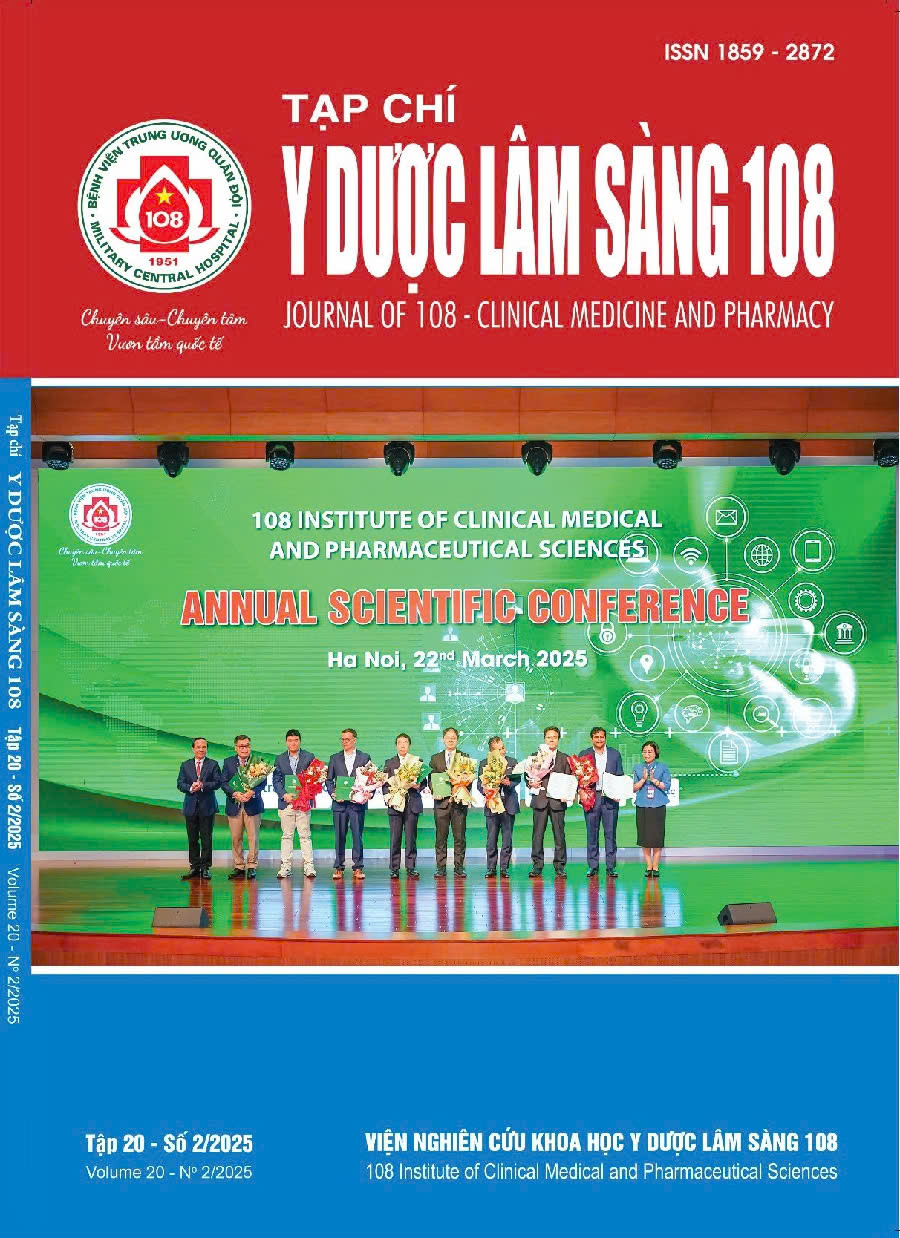Assessment of some risk factors causing acute pancreatitis post-ERCP with impact on the pancreatic duct
Main Article Content
Keywords
Abstract
Objective: To evaluate some risk factors for acute pancreatitis (AP) after endoscopic retrograde cholangiopancreatography (ERCP) with pancreatic duct involvement at the 108 Military Central Hospital. Subject and method: A retrospective study of 170 patients undergoing ERCP with pancreatic duct involvement at the 108 Military Central Hospital from January 2021 to March 2024, divided into the PEP (post-ERCP pancreatitis) and non-PEP groups. Result: The average age of the PEP group was 60.6 ± 20.0, and that of the non-PEP group was 63.4 ± 14.9. The male/female ratio in the PEP group was 1/1, and that ratio in the non-PEP group was 2.57/1 (p<0.05). The subjects of intervention were mainly benign patients. There was no difference in the size and the number of the stones between the two groups. Papilla type 2 and 4 were common in the PEP group (69.6%), papilla type 1 and 3 were standard in the non-PEP group. Diverticulosis and ERCP sphincterotomy were similar in the two groups. Multiple papillary catheterization into the pancreatic duct was 58.6% in the PEP group and 28.0% in the non-PEP group. Technically, Oddi dilation differed between the two groups (p<0.002); pre-cut and stent placement were not different. Intervention time in the PEP group was longer than in the non-PEP group (44.49 ± 13.83 minutes vs. 41.25 ± 16.32 minutes). Conclusion: Female gender, type of papilla, multiple papillary catheterization into the pancreas, and Oddi muscle dilation were risk factors for PEP.
Article Details
References
2. Jang DK, Kim J, Paik CN, Kim JW, Lee TH, Jang JY, Yoon SB, Lee JK (2022) Endoscopic retrograde cholangiopancreatography-related adverse events in Korea: A nationwide assessment. United Eur. Gastroenterol. J 10: 73-79.
3. Kienbauer M, Duller C, Gschwantler M, Puspok A, Schofl R, Kapral C (2018) Austrian benchmarking project for ERCP: A 10-year report. Z. Gastroenterol 56: 1227-1236.
4. Dumonceau JM, Kapral C, Aabakken L, Papanikolaou IS, Tringali A, Vanbiervliet G, Beyna T, Dinis-Ribeiro M, Hritz I, Mariani A et al (2020) ERCP-related adverse events: European Society of Gastrointestinal Endoscopy (ESGE) Guideline. Endoscopy 52: 127-149.
5. Cotton PB, Lehman G, Vennes J, Geenen JE, Russell RC, Meyers WC, Liguory C, Nickl N (1991) Endoscopic sphincterotomy complications and their management: An attempt at consensus. Gastrointest. Endosc 37: 383-393.
6. Freeman ML, Nelson DB, Sherman S, Haber GB, Herman ME, Dorsher PJ, Moore JP, Fennerty MB, Ryan ME, Shaw MJ et al (1996) Complications of endoscopic biliary sphincterotomy. N. Engl. J. Med 335: 909-918.
7. Ding X, Zhang F, Wang Y (2015) Risk factors for post-ERCP pancreatitis: A systematic review and meta-analysis. Surgeon 13: 218-229.
8. El Nakeeb A, El Hanafy E, Salah T, Atef E, Hamed H, Sultan AM, Hamdy E, Said M, El Geidie AA, Kandil T, El Shobari M, El Ebidy G (2016) Post-endoscopic retrograde cholangiopancreatography pancreatitis: Risk factors and predictors of severity. World J Gastrointest Endosc 8(19): 709-715.
9. Chen PH, Tung CF, Peng YC, Yeh HZ, Chang CS, Chen CC (2020) Duodenal major papilla morphology can affect biliary cannulation and complications during ERCP, an observational study. BMC Gastroenterol 20: 310.
10. Cheng CL, Sherman S, Watkins JL, Barnett J, Freeman M, Geenen J (2006) Risk factors for post-ERCP pancreatitis: A prospective multicenter study. Am J Gastroenterol 101(2006): 139-147.
11. Lee YS, Cho CM, Cho KB, Heo J, Jung MK, Kim SB, Kim KH, Kim TN, Lee DW, Han J et al (2021) Difficult Biliary Cannulation from the Perspective of Post-Endoscopic Retrograde Cholangiopancreatography Pancreatitis: Identifying the Optimal Timing for the Rescue Cannulation Technique. Gut Liver 15: 459-465.
12. Testoni PA, Mariani A, Aabakken L, Arvanitakis M, Bories E, Costamagna G, Devière J, Dinis-Ribeiro, M, Dumonceau JM, Giovannini M et al (2016) Papillary cannulation and sphincterotomy techniques at ERCP: European Society of Gastrointestinal Endoscopy (ESGE) Clinical Guideline. Endoscopy 48: 657-683.
 ISSN: 1859 - 2872
ISSN: 1859 - 2872
